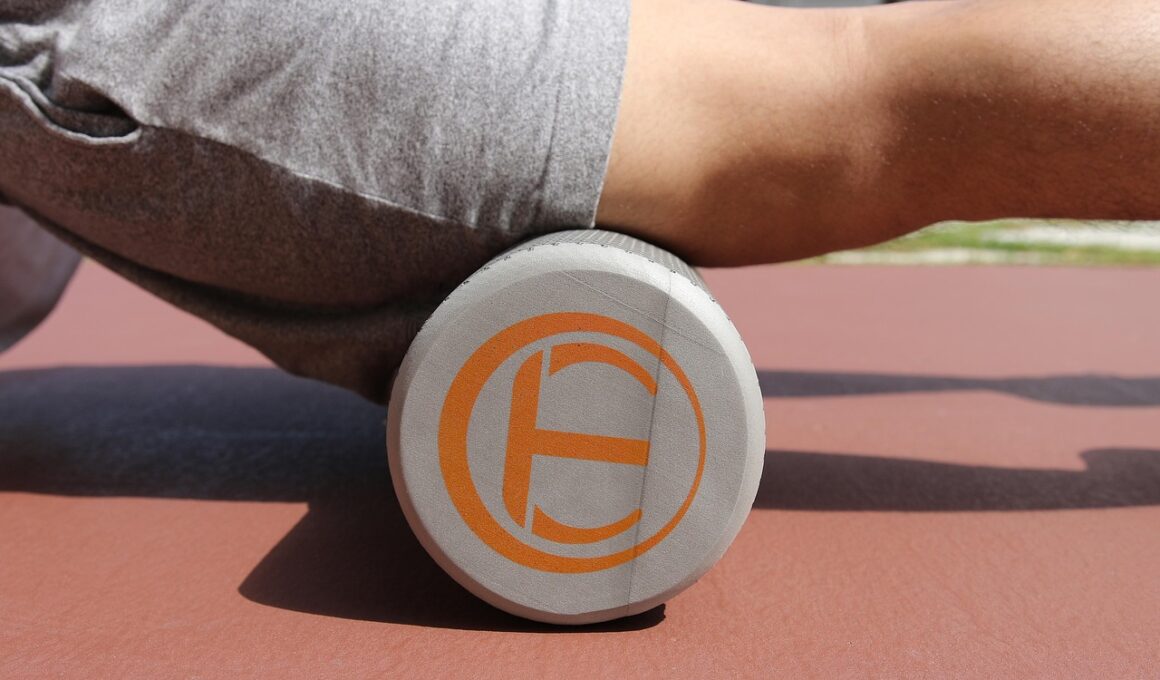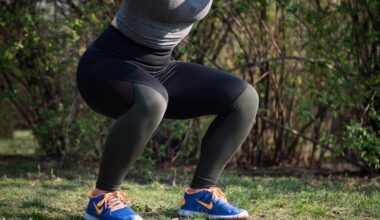Full Body Foam Rolling Routine for Optimal Flexibility
Foam rolling is an exceptional practice that enhances flexibility and mobility across various muscle groups. By applying targeted pressure, a foam roller helps to alleviate muscle tension and release fascial restrictions. This process, referred to as self-myofascial release, aids in restoring proper muscle function and increasing the range of motion in joints. Regularly incorporating foam rolling techniques into your routine can lead to improved athletic performance, reduced risk of injury, and faster recovery from workouts. To get the most out of this practice, develop a comprehensive routine that targets every major muscle group. It is essential to approach practices gradually, as excessive pressure can lead to soreness or injuries. Begin with gentle techniques before progressing to deeper rolls. For maximum benefits, include rolling sessions before and after workouts with a focus on areas like quads, hamstrings, calves, and back. Stay patient and consistent as adapting to foam rolling may take time. In addition, pairing foam rolling with other flexibility exercises can yield better overall results.
The Importance of Targeting Major Muscle Groups
When performing a full body foam rolling routine, paying attention to major muscle groups is crucial for effective flexibility enhancement. These muscle groups, which include the quadriceps, hamstrings, glutes, lower back, and shoulders, experience tightness as a result of daily activities, exercise, or prolonged sitting. By focusing on these areas, you can experience significant improvement in overall mobility and flexibility. To achieve the desired effects, aim to spend at least one to two minutes rolling each targeted muscle group. Begin with the quadriceps by lying face down and rolling from the top of the knee to the hip joint. Proceed to the hamstrings by turning over and rolling from the knee to the sit bone. Don’t forget the glutes, which are a large muscle group that can restrict hip mobility. While rolling, ensure that you breathe deeply to help relax your muscles and promote a sense of overall well-being. This can also reduce any discomfort experienced during the process of foam rolling, encouraging consistent practice.
To maximize the benefits of your foam rolling routine, remember to include various rolling techniques and positions. Different angles and movements can target specific muscle fibers and alleviate tension more effectively. Use slow, controlled movements while rolling over each area, allowing the foam roller to sink into the muscle tissue. For added intensity, adjust body weight and positioning; leaning into the roller can help release stubborn knots and trigger points. Try incorporating techniques like side-lying or cross-body rolling for the lats and lower back, enhancing flexibility in those regions. When addressing tight spots, hold the pressure for 20 to 30 seconds until you feel a softening of the muscle. Keep in mind that foam rolling should not be overly painful. Work within a tolerable range to avoid soreness or injuries. After rolling, consider engaging in dynamic stretching to further promote flexibility and facilitate movement patterns. Always listen to your body and modify your routine according to your individual needs and pain responses. With consistency and dedication, you can significantly enhance your flexibility and mobility.
Incorporating Foam Rolling into Your Routine
Integrating foam rolling into your fitness regimen can greatly contribute to improved performance and recovery. Consider scheduling foam rolling sessions on recovery days or post-workout to help your muscles recuperate. Aim to target all major muscle groups at least twice a week for optimal results. As you become more experienced with foam rolling techniques, you can develop a personalized routine that addresses your specific tightness areas. Additionally, consider pairing foam rolling with other recovery techniques such as stretching and hydrating adequately before and after workouts. Implementing these practices encourages overall muscle health and promotes long-lasting flexibility gains. Another strategy is to combine foam rolling with yoga or Pilates sessions to complement each practice and enhance overall body awareness. Being mindful of your body’s feedback will help you determine the effectiveness of your rolling techniques. Lastly, keeping a foam rolling log can help track progress and changes in flexibility, allowing you to see improvements over time. With time and commitment, these practices can transform your flexibility and mobility, positively impacting your fitness journey.
To ensure that foam rolling is a productive and safe experience, it is vital to follow some best practices. Start by choosing the right foam roller for your skill level; beginners may benefit from softer rollers, while more experienced users might opt for firmer ones. In a full body routine, structure each session to allow adequate time for each muscle group. Focus on areas that tend to become tight during exercise, such as hip flexors and IT bands, paying attention to your body’s response. If you experience increased pain, adjust the pressure or technique used to roll those areas. Pre-foam rolling warm-up is recommended, as warming up the muscles can lead to better results, increasing blood flow and making the muscles more pliable. Incorporating foam rolling as a warm-up or cooldown will help your body prepare for exercise, improving overall performance. Experiment with different techniques and positions to find what works best for you, ensuring that each session feels beneficial and helps to promote long-term flexibility improvements.
Foam Rolling Techniques for Specific Areas
To enhance the effectiveness of your routine, consider specific foam rolling techniques tailored to individual muscle groups. For instance, targeting the thoracic spine can improve posture and reduce upper back tension. Start by positioning the foam roller horizontally under your upper back, using your legs and arms to gently roll up and down. For the calves, sit on the floor with the foam roller under your lower leg, gradually shifting your weight forward and backward to release tight spots. The lower back may require more care; opt for gentle rolls on either side of the spine while ensuring not to roll directly on the spine itself. Shoulders can benefit from using the foam roller vertically against a wall, with your body leaning into it to target any tightness in the rotator cuff muscles. Finally, incorporating deep breathing techniques also aids relaxation during foam rolling, as increased oxygen flow improves muscle recovery, helping reduce post-workout soreness. These specific techniques will ensure you maximize flexibility gains in your routine.
In summary, foam rolling is an invaluable addition to any fitness regimen aimed at improving flexibility and mobility. By targeting specific muscle groups with effective techniques, you can ensure comprehensive muscle health and recovery. Always listen to your body’s feedback throughout the process, adjusting techniques and pressure to ensure safety and comfort. Remember that consistency and patience are essential in achieving lasting results when it comes to flexibility improvements. By establishing a routine that incorporates foam rolling along with other recovery practices, you maximize your potential for enhancing athletic performance. As new techniques are learned, consider sharing your insights with others in fitness communities, as effective routines can help promote overall health and wellness. Look forward to the benefits of regular foam rolling, including increased flexibility, reduced muscle soreness, and enhanced overall physical function. As you become more familiar with your body’s needs, your foam rolling routine can evolve, ensuring it remains both effective and enjoyable. Embrace the journey towards achieving optimal flexibility and mobility.
Ultimately, foam rolling should be seen as a means to cultivate a greater sense of body awareness. This awareness will help you connect with your muscles, guiding you to identify areas that need attention. In doing so, you not only improve physical flexibility, but also increase your mind-body connection for holistic fitness. Encourage friends and fellow athletes to incorporate foam rolling into their routines as well, showcasing how simple practices can yield profound benefits. Share your journey and inspire others to make mindful choices about their physical well-being. By fostering a strong community around foam rolling techniques, you unlock the potential for collective progress. Over time, you will likely see improvements not only in your flexibility but also in your overall athleticism. As always, consider consulting a fitness professional if you have any concerns about your technique or approach. Ultimately, foam rolling is a simple yet effective strategy for enhancing flexibility, diverse enough to address the needs of all fitness levels. Join the foam rolling community and start your journey towards optimal flexibility today, revolutionizing your movement and quality of life.


